Effects of Fluency Oriented Instruction on Motivation for Reading of Struggling Readers
Abstract
1. Introduction
1.1. Background
1.2. Description of Study
1.3. Rationale for Fluency Oriented Reading Instruction
1.4. Fluency Oriented Instruction and Struggling Readers
1.5. Motivation and Reading
1.6. Importance of Motivation for Struggling Readers
2. Methodology
2.1. Research Questions
- What are the effects of FORI on the reading self-efficacy of struggling readers?
- What are the effects of FORI on the reading orientation of struggling readers?
- What are the effects FORI on the perceived difficulty with reading of struggling readers?
2.2. The Research Subjects and Participants
2.3. Data Collection
Teacher Questionnaire Validity
2.4. The Reading Intervention
Intervention Fidelity
2.5. Teacher Professional Development
2.6. Scoring the Motivation for Reading Questionnaires
2.6.1. Scoring the Student Survey (S—YRMQ)
2.6.2. Scoring the Teacher Survey (T-YRMR)
2.6.3. Data Analysis for Interviews
3. Results
3.1. Reading Self-Efficacy of Students
3.2. Reading Orientation of Students
3.3. Perceived Reading Difficulty of Students
3.4. Statistical Analysis of Reading Motivation Findings
4. Discussion
“The way that we conducted the lessons for each unit had a real effect on the children’s confidence and self-concept around reading. When they are asked to read there is no fear of making a mistake....even the weakest readers in my group experienced success in every lesson. Of course they still struggled on individual words and needed a lot of support but I found the real key was the gradual release of responsibility.” [74]
“It was like someone unlocked the doors of the reading kingdom for children, turned on the lights and invited them to the party … and they came… and more importantly they stayed.” [77]
“When you take responsibility and model the reading for the child, you remove the fear of making a mistake. At first I wasn’t totally convinced as I thought that they would just learn it off by heart but modelling the reading was so empowering.” [74]
“When you read for the children first, everybody experiences success at the same time. You could then release the responsibility at different rates with different children … it was real differentiation in action I suppose.” [78]
“Modelling first was the key for me. It was so effective. I recorded myself reading the text fluently and then we would all read with the recording … you know choral reading. Eventually even the weakest readers were reading with intonation. The way I looked at it was if I was teaching someone to bake a cake I would probably demonstrate first and then give assistance after that as I saw fit.” [78].
- R: The reading orientation ratings for some of your students increased dramatically from pre- to post-intervention. Can you tell me more about this?
- LSC1: These children were selected for the intervention because of their lack of motivation for reading and particularly their low level of interest. They would rarely ever read unless you asked them to and would never ask to bring books home. At free play time it was unlikely that they would ever choose a book as their activity even when we had the star system going for the most books read in a week.
- R: And what happened that changed your opinion?
- LSC1: It was amazing to see the transformation as the intervention went on. They loved the games we played each day and were really competitive. I know that they had to bring the FORI books home every night but they also asked to bring other books as well. One child XXXX was so motivated to improve her time on the word dash activity that she wrote all the words down in her copy to practice them at home …. and the amount they were reading was another dramatic change. It was strange because it wasn’t as if they suddenly became excellent readers. It was that they enjoyed reading and as a result they read more.
4.1. Role of Parents
4.2. Practical Implications
4.3. Limitations
4.4. Recommendations for future research
5. Conclusions
Funding
Acknowledgments
Conflicts of Interest
References and Notes
- OECD. Skills Matter: Results from the Survey of Adult Skills, OECD Skills Studies; OECD Publishing: Paris, France, 2016. [Google Scholar] [CrossRef]
- Shiel, G.; Kelleher, C.; McKeown, C.; Denner, S. Future ready? The Performance of 15-Year-Olds in Ireland on Science, Reading Literacy and Mathematics in PISA 2015; Educational Research Centre: Dublin, Ireland, 2016. [Google Scholar]
- Department of Education and Science (DES). Special Educational Needs: A Continuum of Support; The Stationery Office: Dublin, Ireland, 2007. [Google Scholar]
- Eurydice. Teaching Reading in Europe: Contexts, Policies and Practices; Education, Audiovisual and Cultural Executive Agency: Brussels, Belgium, 2011. [Google Scholar]
- Allington, R.L. What Really Matters for Struggling Readers: Designing Research-Based Programs, 3rd ed.; Allyn & Bacon: Boston, UK, 2013. [Google Scholar]
- Taylor, R.T.; McAtee, R. Turning a new page to life and literacy. J. Adolesc. Adult Lit. 2003, 46, 476–481. [Google Scholar]
- Becker, M.; McElvany, N.; Kortenbruck, M. Intrinsic and extrinsic reading motivation as predictors of reading literacy: A longitudinal study. J. Educ. Psychol. 2010, 102, 773–785. [Google Scholar] [CrossRef]
- McGeown, S.P.; Osborne, C.; Warhurst, A.; Norgate, R.; Duncan, L.G. Understanding children’s reading activities: Reading motivation, skill and child characteristics as predictors. J. Res. Read. 2016, 39, 109–125. [Google Scholar] [CrossRef]
- Wigfield, A.; Guthrie, J.T. Relations of children’s motivation for reading to the amount and breadth of their reading. J. Educ. Psychol. 1997, 89, 420–432. [Google Scholar] [CrossRef]
- Petscher, Y. A meta-analysis of the relationship between student attitudes towards reading and achievement in reading. J. Res. Read. 2010, 33, 335–355. [Google Scholar] [CrossRef]
- Nag, S.; Vagh, S.B.; Dulay, K.M.; Snowling, M.J. Home literacy, school Language and children literacy attainments: A systematic review of evidence from low- and middle-income countries. Rev. Educ. 2019, 7, 91–150. [Google Scholar] [CrossRef]
- Poskiparta, E.; Niemi, P.; Lepola, J.; Ahtola, A.; Laine, P. Motivational-emotional vulnerability and difficulties in learning to read and spell. Br. J. Educ. Psychol. 2003, 73, 187–206. [Google Scholar] [CrossRef]
- Cabral-Marquez, C. Motivating Readers: Helping students set and attain personal reading goals. Read. Teach. 2015, 68, 464–472. [Google Scholar] [CrossRef]
- Edmunds, K.M.; Bauserman, K.L. International Reading Association. What Teachers Can Learn about Reading Motivation through Conversations with Children. Read. Teach. 2006, 59, 414–424. [Google Scholar] [CrossRef]
- Stahl, S.A.; Heubach, K.M.; Cramond, B. Fluency-Oriented Reading Instruction; (Research Report No. 79); National Reading Research Center, University of Georgia and University of Maryland: Athens, GA, USA, 1997. [Google Scholar]
- Miller, J.; Schwanenflugel, P.J. A longitudinal study of the development of reading prosody as a dimension of oral reading fluency in early elementary school children. Read. Res. Q. 2008, 43, 336–354. [Google Scholar] [CrossRef]
- Early Reading Expert Panel. A Guide to Effective Instruction in Reading: Kindergarten to Grade 3; Ministry of Education: Toronto, ON, Canada, 2003.
- Rasinski, T.V. Creating Fluent Readers. Educ. Leadersh. 2004, 61, 46–51. [Google Scholar]
- Richards, M. Be a good detective: Solve the case of oral reading fluency. Read. Teach. 2000, 53, 534–539. [Google Scholar]
- National Reading Panel. Teaching Children to Read: An Evidence Based Assessment of the Scientific Research Literature on Reading and its Implications for Reading Instruction; National Institute of Child Health and Human Development, US Government Printing Office: Washington, DC, USA, 2000. [Google Scholar]
- Osborn, J.; Lehr, F.; Hiebert, E. A Focus on Fluency; Pacific Resources for Education and Learning: Honolulu, HI, USA, 2003. [Google Scholar]
- Kamil, M.L.; Pearson, P.D.; Moje, E.B.; Afflerbach, P.P. Handbook of Reading Research; Routledge: New York, NY, USA, 2011; Volume 4. [Google Scholar]
- Kuhn, M.R.; Stahl, S.A. Fluency: A review of developmental and remedial strategies. J. Educ. Psychol. 2003, 95, 1–19. [Google Scholar] [CrossRef]
- Center, Y. Beginning Reading: A Balanced Approach to Reading Instruction in the First Three Years at School; Allen & Unwin: Sydney, Australia, 2005. [Google Scholar]
- Neuman, S.; Dickinson, D. (Eds.) Handbook of Early Literacy Research; Guilford Press: New York, NY, USA, 2011; Volume 3. [Google Scholar]
- Paris, S.G. Developmental differences in early reading skills. In Handbook of Early Literacy Research; Neuman, S., Dickinson, D., Eds.; Guilford Press: New York, NY, USA, 2011; Volume 3, pp. 228–241. [Google Scholar]
- Samuels, S.J. Reading fluency: Its development and assessment. In What Research Has to Say about Reading Instruction, 3rd ed.; Farstrup, A.E., Samuels, S.J., Eds.; International Reading Association: Newark, DE, USA, 2002; pp. 166–183. [Google Scholar]
- Stahl, S.A.; Heubach, K.M. Fluency-oriented reading instruction. J. Lit. Res. 2005, 37, 25–60. [Google Scholar] [CrossRef]
- Schwanenflugel, P.J.; Hamilton, A.M.; Kuhn, M.R.; Wisenbaker, J.M.; Stahl, S.A. Becoming a fluent reader: Reading skill and prosodic features in the oral reading of young readers. J. Educ. Psychol. 2004, 96, 119–129. [Google Scholar] [CrossRef] [PubMed]
- Miller, J.; Schwanenflugel, P.J. Prosody of syntactically complex sentences in the oral reading of young children. J. Educ. Psychol. 2006, 98, 839–853. [Google Scholar] [CrossRef] [PubMed]
- Kuhn, M.R.; Stahl, S.A. Fluency: A review of developmental and remedial practices. In Theoretical Models and Processes of Reading, 5th ed.; Ruddell, R.B., Unrau, N.J., Eds.; International Reading Association: Newark, DE, USA, 2004; pp. 412–453. [Google Scholar]
- Duke, N.K.; Pressley, M.; Hilden, K. Difficulties in reading comprehension. In Handbook of Language and Literacy; Development and Disorders; Stone, C.A., Silliman, E.R., Ehren, B.J., Apel, K., Eds.; Guilford: New York, NY, USA, 2004; pp. 501–520. [Google Scholar]
- Samuels, S.J.; Farstrup, A.E. What Research Has to Say about Reading Instruction, 4th ed.; International Reading Association: Newark, DE, USA, 2011. [Google Scholar]
- Samuels, S.J. The method of repeated readings. Read. Teach. 1979, 32, 403–408. [Google Scholar]
- Gambrell, L.B. Motivation in the School Reading Curriculum. J. Read. Educ. 2011, 37, 5–14. [Google Scholar]
- Baker, L.; Wigfield, A. Dimensions of children’s motivation for reading and their relations to reading activity and reading achievement. Read. Res. Q. 1999, 34, 452–477. [Google Scholar] [CrossRef]
- Guthrie, J.T.; Coddington, C.S. Reading motivation. In Handbook of Motivation at School; Wentzel, K.R., Wigfield, A., Eds.; Routledge: New York, NY, USA, 2009; pp. 503–525. [Google Scholar]
- Wigfield, A.; Eccles, J.S.; Rodriguez, D. The development of children’s motivation in school contexts. In Review of Research in Education 23; Iran-Nejad, A., Pearson, P.D., Eds.; American Educational Research Association: Washington, DC, USA, 1998; pp. 73–118. [Google Scholar]
- Palmer, B.M.; Codling, R.M.; Gambrell, L.B. In their own words: What elementary students have to say about motivation to read. Read. Teach. 1994, 48, 176–178. [Google Scholar]
- Gambrell, L.B.; Malloy, J.A.; Mazzoni, S.A. Evidenced based practices for comprehensive literacy instruction. In Best Practices in Literacy Instruction; Gambrell, L.B., Morrow, L.M., Pressley, M., Eds.; Guilford Press: New York, NY, USA, 2007; pp. 11–29. [Google Scholar]
- Morgan, L.P.; Fuchs, D. Is there a bidirectional relationship between childrens’ reading skills and reading motivation? Except. Child. 2007, 73, 165–183. [Google Scholar] [CrossRef]
- Sweet, A.P.; Guthrie, J.T.; Ng, M. Teachers’ perceptions and students’ reading motivations. J. Educ. Psychol. 1998, 90, 210–223. [Google Scholar] [CrossRef]
- Coddington, S.C.; Guthrie, T.J. Teacher and student perceptions of boys’ and girls’ reading motivation. Read. Psychol. 2009, 30, 225–249. [Google Scholar] [CrossRef]
- Chapman, J.W.; Tunmer, W.E.; Prochnow, J.E. Early reading-related skills and performance, reading self-concept, and the development of academic self-concept: A longitudinal study. J. Educ. Psychol. 2000, 92, 703–708. [Google Scholar] [CrossRef]
- Cartwright, K.B.; Marshall, T.R.; Wray, E. A longitudinal study of the role of reading motivation in primary students’ reading comprehension: Implications for a less simple view of reading. Read. Psychol. 2016, 37, 55–59. [Google Scholar] [CrossRef]
- Quirk, M.; Schwanenflugel, P.J.; Webb, M. A Short-Term Longitudinal Study of the Relationship between Motivation to Read and Reading Fluency Skill in Second Grade. J. Lit. Res. JLR 2009, 41, 196–227. [Google Scholar] [CrossRef]
- Guthrie, J.T.; Anderson, E. Engagement in reading: Processes of motivated, strategic, knowledgeable, social readers. In Engaged Reading: Processes, Practices, and Policy Implications; Guthrie, J.T., Alvermann, D.E., Eds.; Teachers College Press: New York, NY, USA, 1999; pp. 17–45. [Google Scholar]
- Oldfather, P.; Wigfield, A. Children’s motivations to read. In Developing Engaged Readers in School and Home Communities; Baker, L., Afflerbach, P., Reinking, D., Eds.; Erlbaum: Mahwah, NJ, USA, 1996; pp. 89–113. [Google Scholar]
- Wigfield, A.; Wilde, K.; Baker, L.; Fernandez-Fein, S.; Scher, D. The Nature of Children’s Reading Motivations, and Their Relations to Reading Fluency and Reading Performance; National Reading Research Center: Athens, GA, USA, 1996. [Google Scholar]
- Wigfield, A.; Guthrie, J.T. Motivation for reading: Individual, home, textual, and classroom perspective. Educ. Psychol. 1997, 32, 57–135. [Google Scholar]
- Guthrie, J.T.; Humenick, N.M. Motivating students to read: Evidence for classroom practices that increase reading motivation and achievement. In The Voice of Evidence in Reading Research; McCardle, P., Chhabra, V., Eds.; Brookes Publishing: Baltimore, MD, USA, 2004; pp. 329–354. [Google Scholar]
- Aunola, K.; Leskinen, E.; Onatsu-Arvilommi, T.; Nurmi, J.E. Three methods for studying developmental change: A case of reading skills and self-concept. Br. J. Educ. Psychol. 2002, 72, 343–364. [Google Scholar] [CrossRef]
- Chapman, J.W.; Tunmer, W.E. Reading difficulties, reading-related self-perceptions, and strategies for overcoming negative self-beliefs. Read. Writ. Q. Overcoming Learn. Diffic. 2003, 19, 5–24. [Google Scholar] [CrossRef]
- Lepola, J.; Poskiparta, E.; Laakkonen, E.; Niemi, P. Developmental Interaction of Phonological and Motivational Processes and Naming Speed in Predicting Word Recognition in Grade 1. Sci. Stud. Read. 2005, 9, 365–396. [Google Scholar] [CrossRef]
- Sideridis, G.D.; Morgan, P.L.; Botsas, G.; Padeliadu, S.; Fuchs, D. Identification of students with learning difficulties based on motivation, metacognition, and psychopathology: A ROC analysis. J. Learning Disabil. 2006, 39, 215–229. [Google Scholar] [CrossRef] [PubMed]
- Chapman, J.W. Learning disabled children’s self-concepts. Rev. Educ. Res. 1998, 58, 347–371. [Google Scholar] [CrossRef]
- Stanovich, P.J.; Jordan, A.; Perot, J. Relative differences in academic self-concept and peer acceptance among students in inclusive classrooms. Remedial Spec. Educ. 1998, 19, 120–126. [Google Scholar] [CrossRef]
- Fulk, B.M.; Brigham, F.J.; Lohman, D.A. (Eds.) Motivation and self-regulation: A comparison of students with learning and behaviour problems. Remedial Spec. Educ. 1998, 19, 300–309. [Google Scholar] [CrossRef]
- Malloy, J.A.; Marinak, B.A.; Gambrell, L.B. (Eds.) Essential Readings in Motivation; International Reading Association: Newark, DE, USA, 2010. [Google Scholar]
- Salonen, P.; Lepola, J.; Niemi, P. The development of first graders’ reading skill as a function of pre-school motivational orientation and phonemic awareness. Eur. J. Psychol. Educ. 1998, 13, 155–174. [Google Scholar] [CrossRef]
- Nelson, J.M.; Manset-Williamson, G. The impact of explicit, self-regulatory reading comprehension strategy instruction on the reading-specific self-efficacy attributions, and affect of students with reading disabilities. Learn. Disabil. Q. 2006, 29, 213–230. [Google Scholar] [CrossRef]
- Guthrie, J.T.; Wigfield, A.; Metsala, J.L.; Cox, K.E. Motivational and cognitive predictors of text comprehension and reading amount. Sci. Stud. Read. 1999, 3, 231–256. [Google Scholar] [CrossRef]
- Pintrich, P.R. Multiple goals, multiple pathways: The role of goal orientation in learning and achievement. J. Educ. Psychol. 2000, 92, 544–555. [Google Scholar] [CrossRef]
- Eccles, J.; Adler, T.F.; Futterman, R.; Goff, S.B.; Kaczala, C.M.; Meece, J.; Midgley, C. Expectancies, values and academic behaviours. In Achievement and Achievement Motives; Spence, J.T., Ed.; W.H. Freeman: San Francisco, CA, USA, 1983. [Google Scholar]
- Guthrie, J.T.; Coddington, C.S.; Wigfield, A. Profiles of reading motivation among African American and Caucasian students. J. Lit. Res. 2009, 41, 317–353. [Google Scholar] [CrossRef]
- Mazzoni, S.A.; Gambrell, L.B.; Korkeamaki, R.L. A cross-cultural perspective of early literacy motivation. J. Read. Psychol. 1999, 20, 237–253. [Google Scholar]
- Wigfield, A.; Guthrie, J.T.; McGough, K. A Questionnaire Measure of Children’s Motivations for Reading; National Reading Research Center: Athens, GA, USA, 1996. [Google Scholar]
- Kuhn, M.R.; Schwanenflugel, P.J. Fluency in the Classroom. The Guilford Press: New York, NY, USA, 2008. [Google Scholar]
- Schwanenflugel, P.J.; Kuhn, M.R.; Morris, R.D.; Morrow, L.M.; Meisinger, E.B.; Woo, D.G.; Quirk, M.; Sevcik, R. Insights into fluency instruction: Short- and long-term effects of two reading programs. Lit. Res. Instr. 2009, 48, 318–336. [Google Scholar] [CrossRef]
- Mehigan, G. Oral reading fluency: A link from word reading efficiency to comprehension. In From Literacy Research to Classroom Practice: Insights and Inspiration; Willoughby, K., Culligan, B., Kelly, A., Mehigan, G., Eds.; Reading Association of Ireland: Dublin, Ireland, 2012; pp. 99–113. [Google Scholar]
- Chapman, J.W.; Tunmer, W.E. Development of young children’s reading self-concepts: An examination of emerging subcomponents and their relationship with reading achievement. J. Educ. Psychol. 1995, 87, 154–167. [Google Scholar] [CrossRef]
- Morrow, L.M.; Asbury, E. Current practices in early literacy development. In Best Practices in Literacy Instruction; Morrow, L.M., Gambrell, L.B., Pressley, M., Eds.; Guilford: New York, NY, USA, 2003; Volume 2, pp. 43–63. [Google Scholar]
- Optiz, M.F.; Rasinski, T.V. Good-Bye Round Robin Reading: 25 Effective Oral Reading Strategies; Heinemann: Portsmouth, NH, USA, 2008. [Google Scholar]
- Field notes of interview with learning support teacher in School A.
- Bandura, A. (Ed.) Exercise of personal and collective efficacy in changing societies. In Self-Efficacy in Changing Societies; Cambridge University Press: Cambridge, UK, 1995; pp. 1–45. [Google Scholar]
- Cambria, J.; Guthrie, J.T. Motivating and Engaging Students in Reading. N. Engl. Read. Assoc. J. 2010, 46, 16–29. [Google Scholar]
- Field notes of interview with learning support teacher in School C.
- Field notes of interview with learning support teacher in School B.
- Baker, L.; Dreher, M.J.; Guthrie, J.T. (Eds.) Engaging Young Readers: Promoting Achievement and Motivation; Guilford Press: New York, NY, USA, 2000. [Google Scholar]
- Stanovich, K.E.; West, R.F.; Cunningham, A.E.; Cipielewski, J.; Siddiqui, S. The role of inadequate print exposure as a determinant of reading comprehension problems. In Reading Comprehension Difficulties: Processes and Interventions; Cornoldi, C., Oakhill, J., Eds.; Erlbaum: Mahwah, NJ, USA, 1996; pp. 15–32. [Google Scholar]
- Guthrie, J.T.; Wigfield, A. Engagement and motivation in reading. In Reading Research Handbook; Kamil, M.L., Mosenthal, P.B., Pearson, P.D., Barr, R., Eds.; Erlbaum: Mahwah, NJ, USA, 2000; Volume 3, pp. 403–424. [Google Scholar]
- Sonnenschein, S.; Baker, L.; Serpell, R.; Schmidt, D. Reading is a source of entertainment: The importance of the home perspective for children’s literacy development. In Play and Literacy in Early Childhood: Research from Multiple Perspectives; Roskos, K.A., Christie, J.F., Eds.; Erlbaum: Mahwah, NJ, USA, 2000; pp. 125–137. [Google Scholar]
- Baker, L.; Serpell, R.; Sonnenschein, S. Opportunities for literacy learning in the homes of urban preschoolers. In Family Literacy: Connections in Schools and Communities; Morrow, L.M., Ed.; International Reading Association: Newark, DE, USA, 1995; pp. 236–252. [Google Scholar]
- Ollila, L.O.; Mayfield, M.I. Home and school together: Helping beginning readers succeed. In What Research Has to Say about Reading Instruction; Samuels, S.J., Farstrup, A.E., Eds.; International Reading Association: Newark, DE, USA, 1992; pp. 17–45. [Google Scholar]
- Afflerbach, P.; Cho, B.Y. The classroom assessment of reading. In Handbook of Reading Research; Kamil, M.L., Pearson, P.D., Moje, E.B., Afflerbach, P.P., Eds.; Routledge: New York, NY, USA, 2011; Volume 4, pp. 478–541. [Google Scholar]
- Agee, J. Literacy, aliteracy, and lifelong learning. New Libr. World 2005, 106, 244–252. [Google Scholar] [CrossRef]
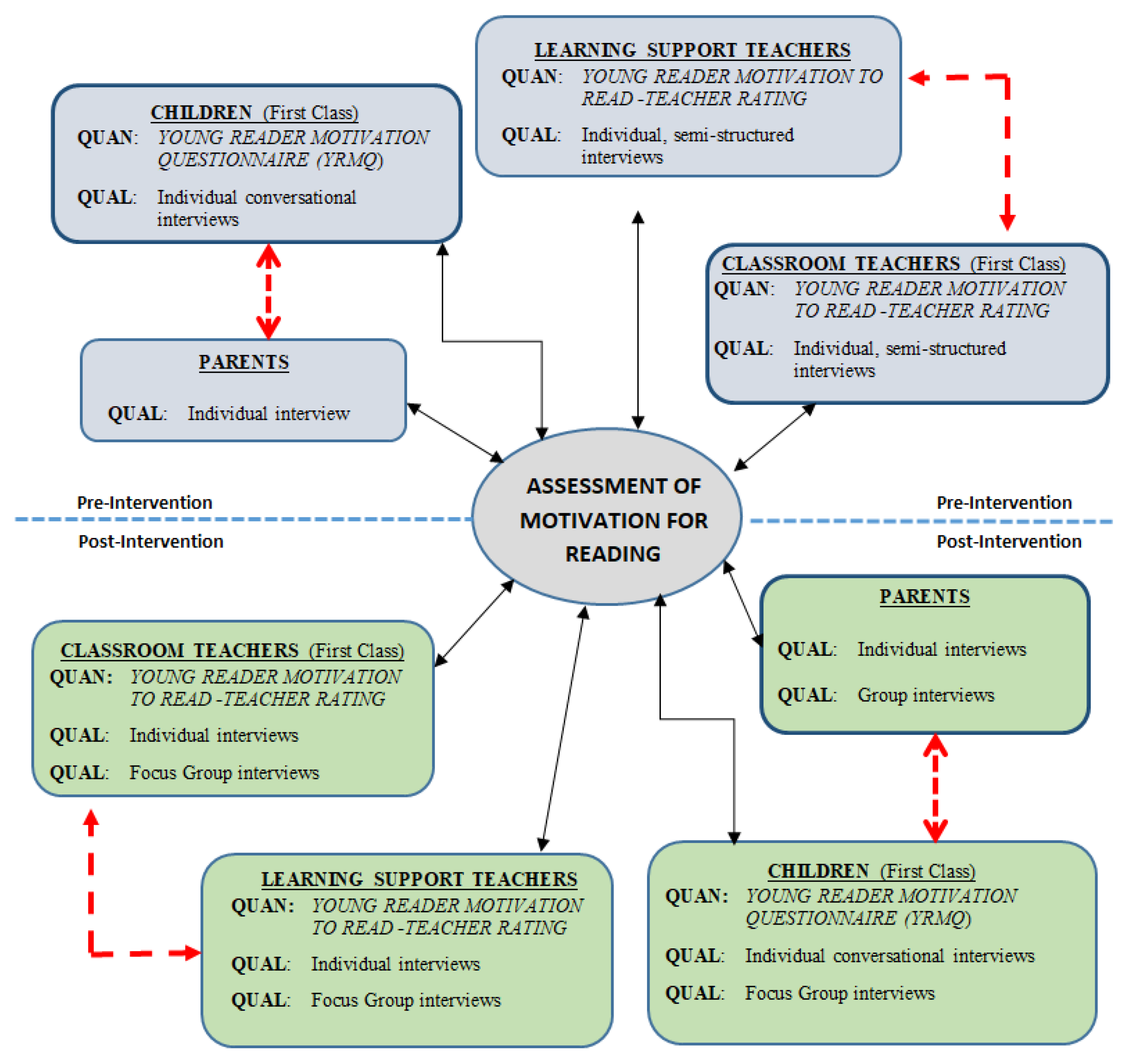

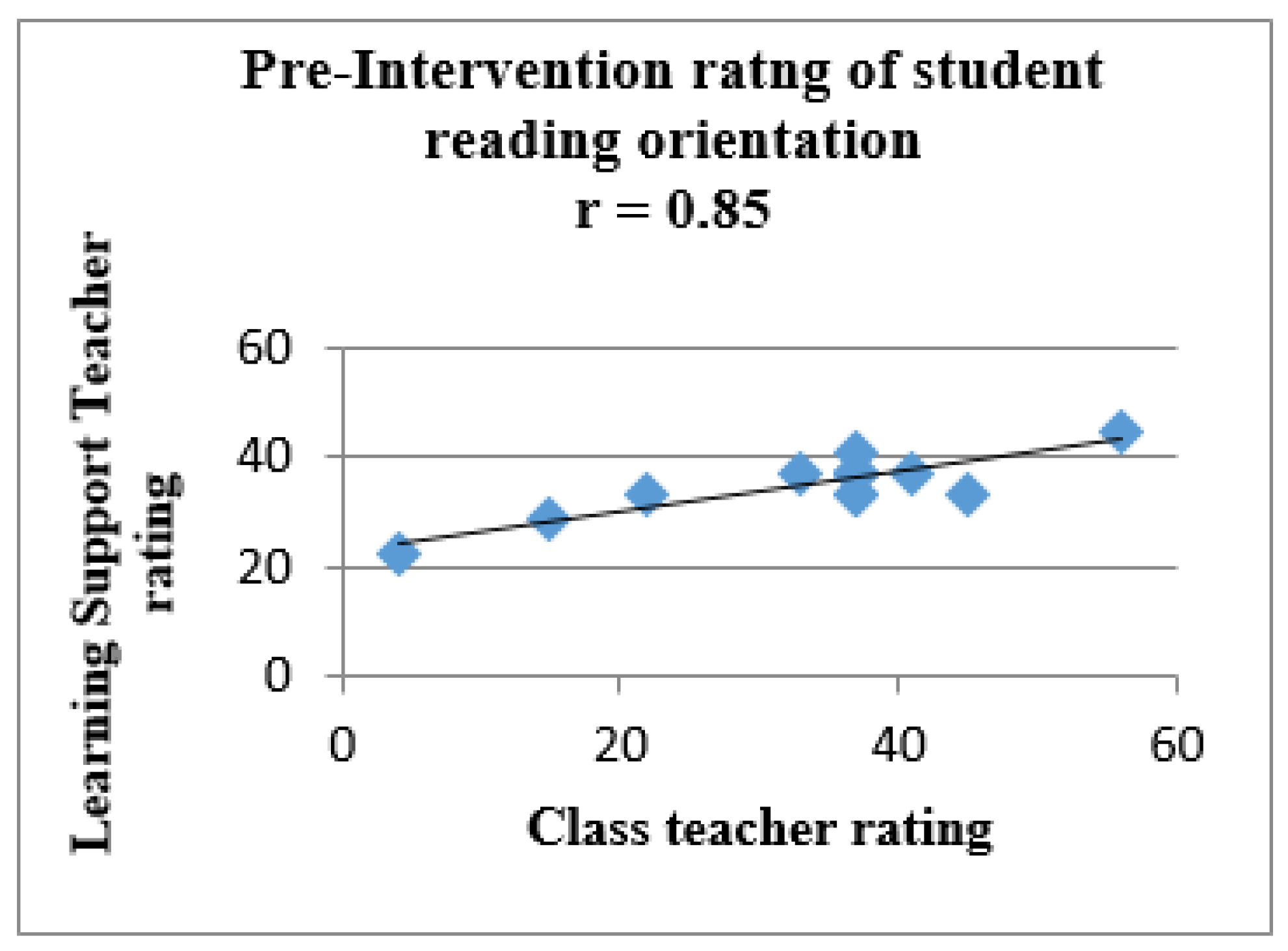
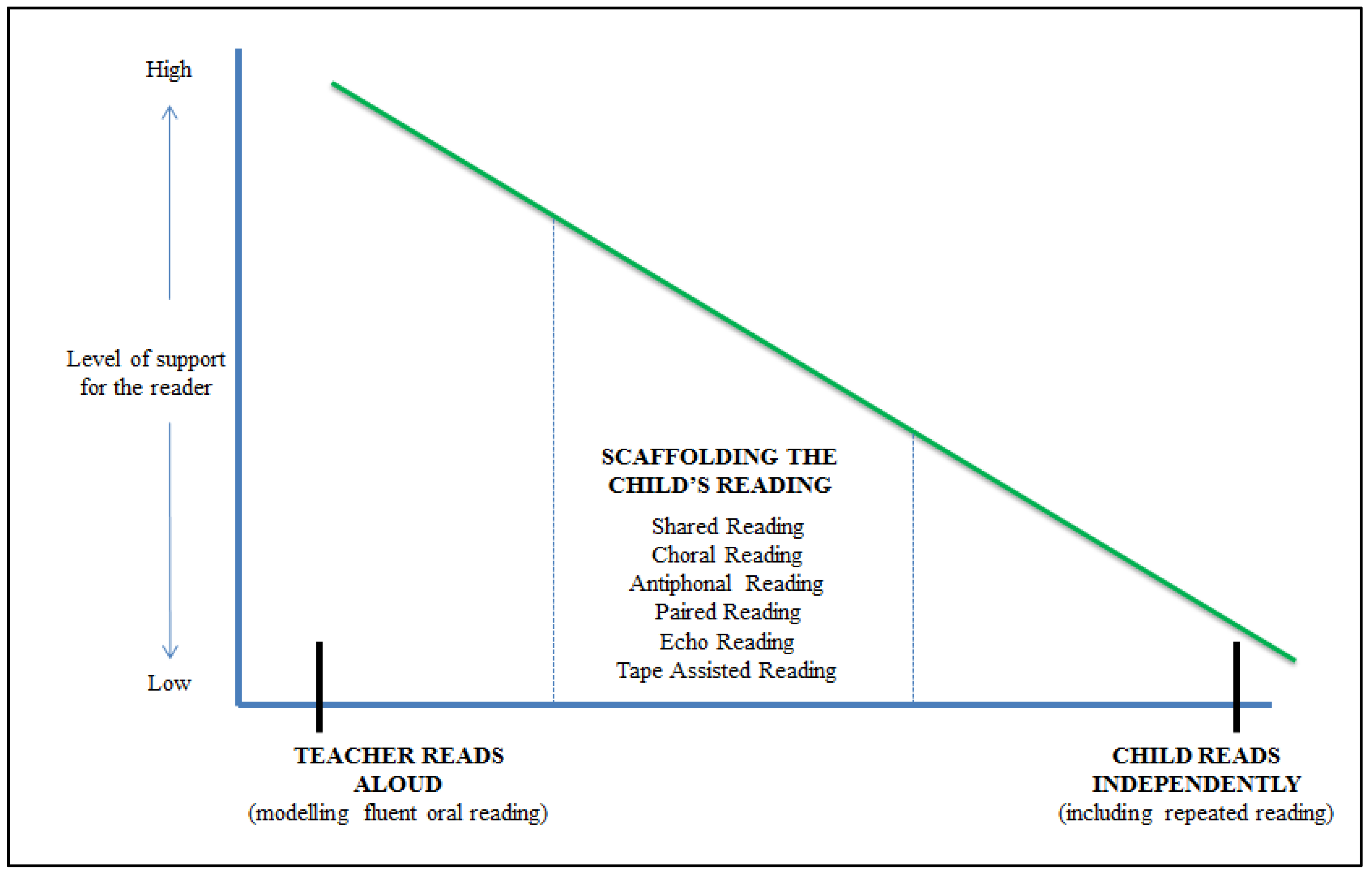
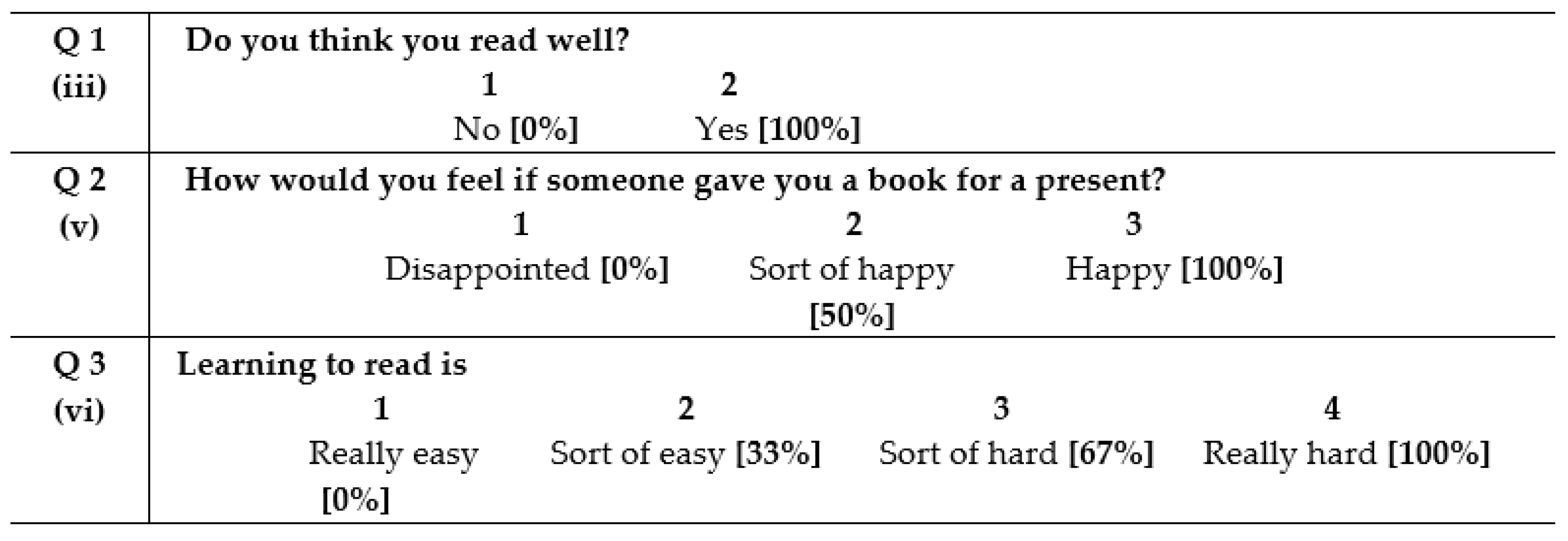
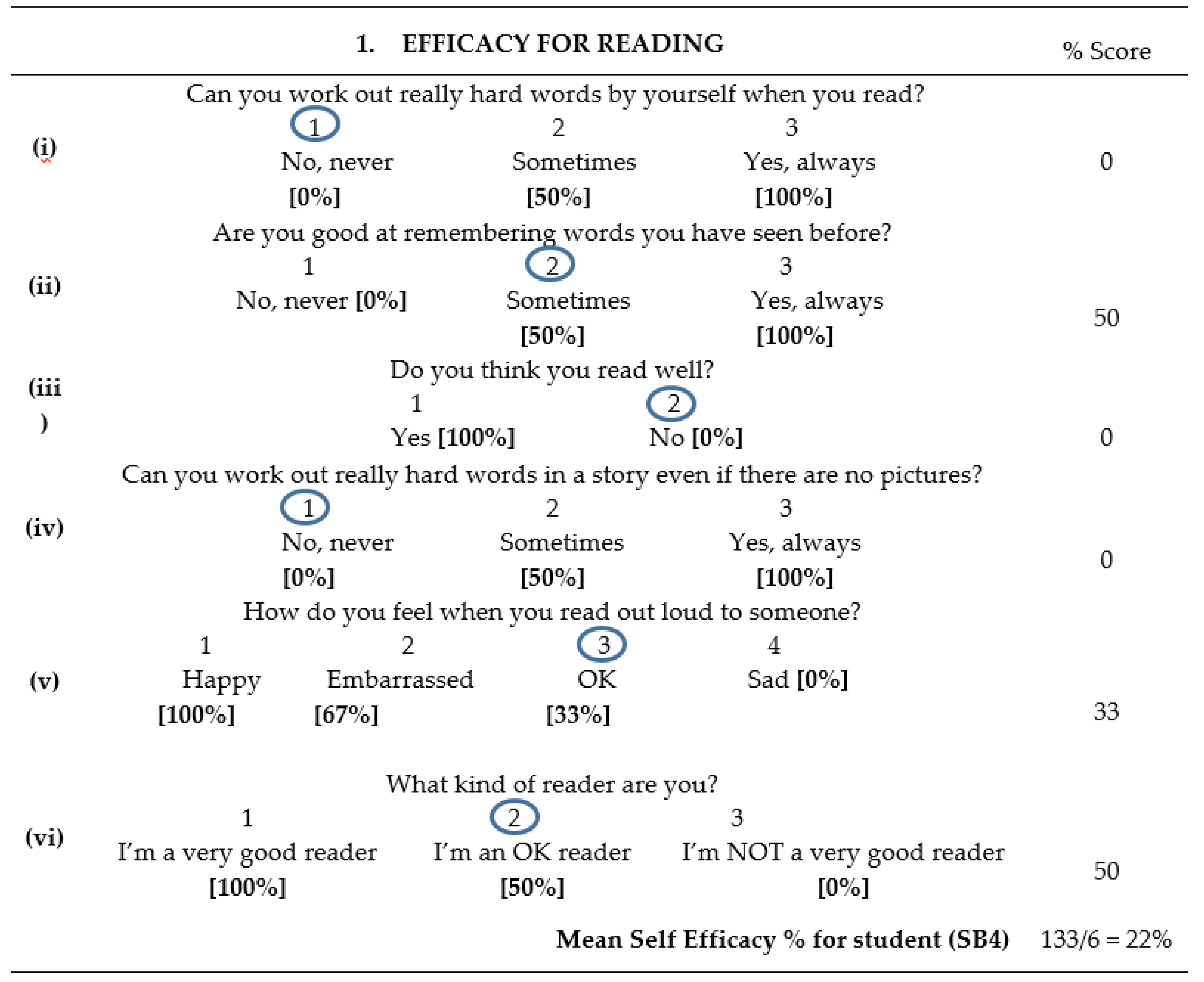
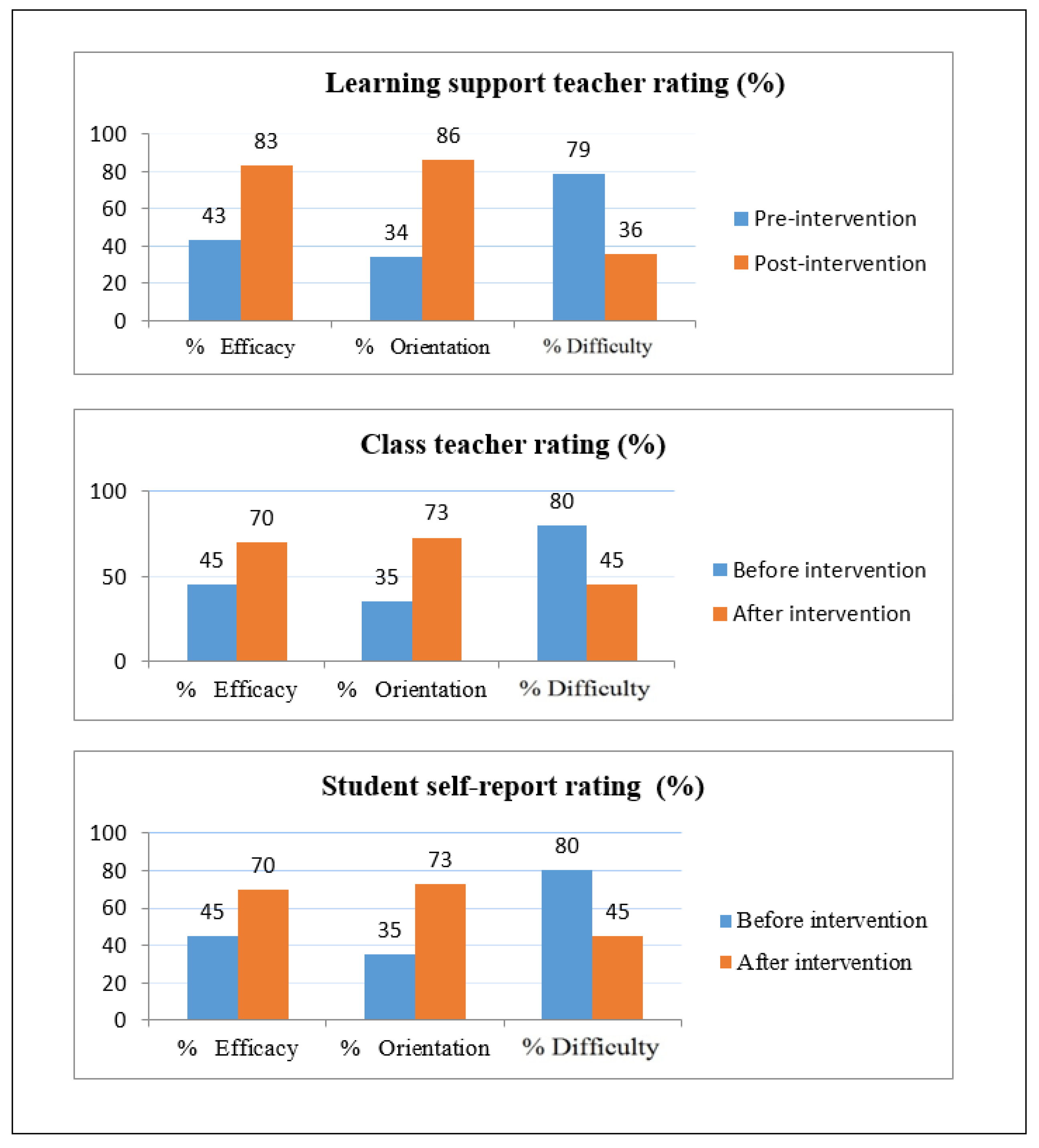
| Research Question | Motivation Constructs Assessed | Data Source | |||||
|---|---|---|---|---|---|---|---|
| Teachers’ Voice [Learning Support and Class Teachers] | Students’ Voice School A, B and C (n = 15) | Parents’ Voice | Researcher | ||||
| Effects of FORI on the motivation for reading of students in First Class | Self-efficacy | QUAN | QUAL | QUAN | QUAL | QUAL | QUAL |
| Perceptions of student efficacy for reading [5 items] | Individual semi-structured interviews Reflective journal | Student efficacy for reading [6 items] | Individual interviews (conducted with survey) | Individual and semi-structured focus group interviews | Field notes | ||
| Reading orientation | Perceptions of student reading orientation [9 items] | Individual semi-structured interviews Reflective journal | Student reading orientation [10 items] | Individual interviews (conducted with survey) | Individual and semi-structured focus group interviews | ||
| Perceived difficulty in reading | Perceptions of student difficulty in reading [6 items] | Individual semi-structured interviews Reflective journal | Student perception of difficulty in reading [6 items] | Individual interviews (conducted with survey) | Individual and semi-structured focus group interviews | ||
| Monday | Tuesday | Wednesday | Thursday | Friday | |
|---|---|---|---|---|---|
| School Activity [based on selected text] | Before Reading Teacher introduces the text (background knowledge, vocabulary, title, pictures, characters, plot) Modelled Reading Teacher reads text or selection of text aloud; students listen Teacher repeats reading of text and students follow along with their own copy Responding to Text Discussion takes place as selection is read to develop text comprehension. Use of graphic organizers (e.g., diagrammatic innovation, story map) Matching Activity: Characters to names, e.g., memory game | Before Reading Retelling the story (wordless books to be used here as visual cue to retelling); recall of key characters and names; character map (diagram) Audio-Assisted Reading Students read along with an audio version of the text.Students practice until they canread the story fluently and accurately Echo Reading Teacher reads one or two sentences…up to a paragraph, and students echo that reading Responding to Text Comprehension developed through various strategies such as student questioning, visualisation, etc. | Before Reading Phrasing: Slide and Glide (Teacher reads text stopping and allowing students to complete phrase) Choral Reading (a) Students choral read same text selection (b) Cumulative choral reading Repeated Choral Reading Students are introduced to the concept of reading for the duration of the one-minute timer while choral reading Responding to Text Sentence Reconfiguration Phrasing: Matching phrases (sentence completion); using phrase strips | Before Reading Phrase grid activity. Dice game where students finish phrase based on the text corresponding to the number that they throw Partner Reading Paired Repeated Reading Same text (partners selected by teacher to ensure mixed ability) Whisperphones used to facilitate multiple synchronous paired reading Individual Whisper Reading Toobaloos used here to facilitate immediate feedback to students as they hear themselves read through the device Responding to Text Write and draw activity based on individual words identified by teacher | Timed Repeated Reading Students are introduced to the concept of reading for the duration of the one-minute timer and recording the WCPM on their graphs. Words provided (and noted) to child after 3 secs if unknown. NOTE: Individual sight word lists can be introduced as a Timed Reading Activity in week 2 Word Study on ‘tricky’ words Students complete activities in individual scrap books, e.g., story map, sentence reconfiguration, phrase completion Performance Element Performance of text and of selected FORI activities, e.g., cumulative choral reading, |
| Motivational Aspect | Introduction to timed reading (character card sheets used for timed reading, e.g., how many characters can you read in a minute) | Sight Word Activity: sight word hunt using wooden templates. Students record the sentence/phrase on their wipe boards | Super Stamps introduced for completion of activities. Stamps recorded in bar graph configuration to depict progress | Motivational resources to be used at teacher’s discretion to encourage performance | Record progress in Timed Repeated Reading on graph STAR recording templateScooby Doo Reading Medals |
| Resources | Texts One-minute timer | Texts Wordless books Wipe boards Home reading log | One-minute timer; Super Stamps Slide and Glide sheetsWipe off phrase strips Home reading log | Whisperphones; Toobaloos Phrase Grids Stickers, stars, cards, smiley erasers; Home reading log | FORI Scrap Books Timed Repeated Reading Graph Home reading log |
| Home Activity | Students take book home and read it to parent/guardian. Home reading log is signed and number of pages recorded | Students take book home and read it to parent/guardian. Home reading log is signed and number of pages recorded | Students take book home and read it to parent/guardian. Home reading log is signed and number of pages recorded | Students take book home and read it to parent/guardian. Home reading log is signed and number of pages recorded |
| Motivation for Reading (School A) Student Self-Rating % | |||
|---|---|---|---|
| Reading Efficacy % | Reading Orientation % | Perceived Difficulty in Reading % | |
| SB1 | 62 | 30 | 72 |
| SB2 | 47 | 70 | 70 |
| SB3 | 72 | 50 | 53 |
| SB4 | 22 | 55 | 75 |
| SB5 | 58 | 40 | 61 |
| Learning Support Teacher Rating % | Class Teacher Rating % | Student Self-Report Rating % | Mean Increase across Ratings | ||||
|---|---|---|---|---|---|---|---|
| Pre-Intervention | Post-Intervention | Pre-Intervention | Post-Intervention | Pre-Intervention | Post-Intervention | ||
| Mean scores for all students | x̅ = 43% | x̅ = 83% | x̅ = 45% | x̅ = 70% | x̅ = 55% | x̅ = 83% | x̅ = 31% |
| Percentage Increase: x̅ = 40% | Percentage Increase: x̅ = 25% | Percentage Increase: x̅ = 28% | |||||
| Learning Support Teacher Rating % | Class Teacher Rating % | Student Self-Report Rating % | Mean Increase across Ratings | ||||
|---|---|---|---|---|---|---|---|
| Pre-Intervention | Post-Intervention | Pre-Intervention | Post-Intervention | Pre-Intervention | Post-Intervention | ||
| Mean scores for all students | x̅ = 34% | x̅ = 86% | x̅ = 35% | x̅ = 73% | x̅ = 49% | x̅ = 69% | x̅ = 36% |
| Percentage Increase: x̅ = 52% | Percentage Increase: x̅ = 38% | Percentage Increase: x̅ = 20% | |||||
| Learning Support Teacher Rating % | Class Teacher Rating % | Student Self-Report Rating % | Mean Increase across Ratings | ||||
|---|---|---|---|---|---|---|---|
| Pre-Intervention | Post-Intervention | Pre-Intervention | Post-Intervention | Pre-Intervention | Post-Intervention | ||
| Mean scores for all students | x̅ = 79 | x̅ = 36 | x̅ = 80 | x̅ = 45 | x̅ = 68 | x̅ = 29 | x̅ = −39% |
| Percentage Increase: x̅ = −43% | Percentage Increase: x̅ = −35% | Percentage Increase: x̅ = −39% | |||||
| Measure | Z | p | |
|---|---|---|---|
| Class teacher | Reading Self-Efficacy | −3.2 | 0.002 |
| Reading Orientation | −3.4 | 0.001 | |
| Perceived Reading Difficulty | −3.4 | 0.001 | |
| Learning support teacher | Reading Self-Efficacy | −3.3 | 0.001 |
| Reading Orientation | −3.4 | 0.001 | |
| Perceived Reading Difficulty | −3.3 | 0.001 | |
| Student | Reading Self-Efficacy | −3.4 | 0.001 |
| Reading Orientation | −3.3 | 0.001 | |
| Perceived Reading Difficulty | −3.4 | 0.001 |
© 2020 by the author. Licensee MDPI, Basel, Switzerland. This article is an open access article distributed under the terms and conditions of the Creative Commons Attribution (CC BY) license (http://creativecommons.org/licenses/by/4.0/).
Share and Cite
Mehigan, G. Effects of Fluency Oriented Instruction on Motivation for Reading of Struggling Readers. Educ. Sci. 2020, 10, 56. https://doi.org/10.3390/educsci10030056
Mehigan G. Effects of Fluency Oriented Instruction on Motivation for Reading of Struggling Readers. Education Sciences. 2020; 10(3):56. https://doi.org/10.3390/educsci10030056
Chicago/Turabian StyleMehigan, Gene. 2020. "Effects of Fluency Oriented Instruction on Motivation for Reading of Struggling Readers" Education Sciences 10, no. 3: 56. https://doi.org/10.3390/educsci10030056
APA StyleMehigan, G. (2020). Effects of Fluency Oriented Instruction on Motivation for Reading of Struggling Readers. Education Sciences, 10(3), 56. https://doi.org/10.3390/educsci10030056




